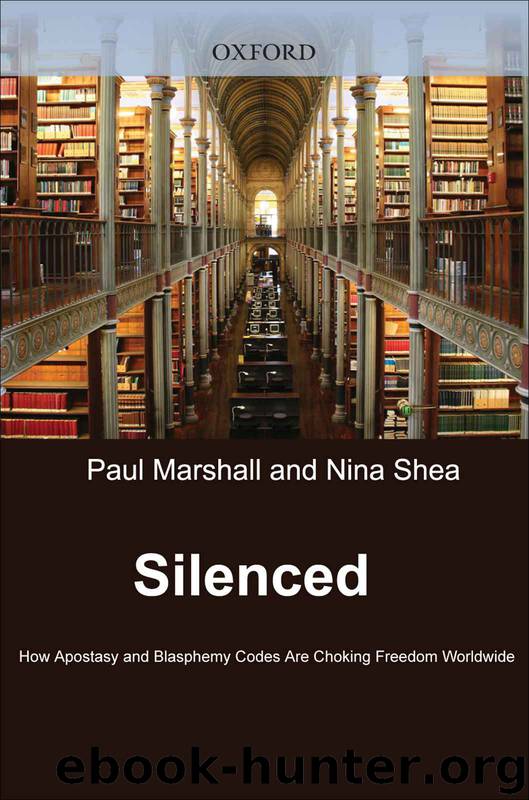Silenced: How Apostasy and Blasphemy Codes are Choking Freedom Worldwide by Paul Marshall & Nina Shea

Author:Paul Marshall & Nina Shea [Marshall, Paul]
Language: eng
Format: epub, mobi
Tags: Silenced
Publisher: Oxford University Press
Published: 2011-10-03T00:00:00+00:00
Cartoons
Denmark
While verbal criticism or vitriol has regularly drawn the attention of Muslim activists and Western legal authorities, it is cartoons that have been at the center of most attention. The 2005–6 global crisis over Jyllands-Posten’s cartoons of Muhammad drew widespread Western legal attention, although cases against publishers in the West have generally failed. In Denmark itself, a complaint by Muslims against the paper was rejected by the Director of Public Prosecutions on March 15, 2006.
Officials considered charges concerning the cartoons under two statutes, one governing blasphemy and one on hate speech. Section 140 of the Danish criminal code states that “any person who, in public, mocks or scorns the religious doctrines or acts of worship of any lawfully existing religious community in this country” may face up to four months in prison. Section 266b provides for a fine or up to two years in jail for “any person who, publicly or with the intention of wider dissemination, makes a statement or imparts other information by which a group of people are threatened, scorned or degraded on account of their race, colour, national or ethnic origin, religion, or sexual inclination.”83
In the interest of protecting freedom of expression, the prosecutor held that both laws should be interpreted narrowly. He concluded that the cartoons were not merely “gratuitous” but had broader social significance that accorded them free speech protection. He also determined, “The drawings that must be assumed to be pictures of Muhammed depict a religious figure, and none of them can be considered to be meant to refer to Muslims in general.” The prosecutor argued that those that did depict Muslims did not do so in a “scornful or degrading” fashion and that a “depiction of a religious figure” was not sufficient to meet Danish standards for a blasphemy ban.
With regard to Section 140, the prosecutor ruled on each drawing individually, noting that all but four were neutral. Of those, he found that the drawing that chastised Islam’s Prophet for “keeping women under yoke” and the image of a sword-wielding Muhammad before two frightened figures in burkas were protected commentary and not an attack against “religious doctrines and acts of worship.” The drawing in which Muhammad tells two angry followers to “relax, it’s just a sketch made by an infidel Dane from South Denmark,” showed the Prophet rejecting violence and so was not scorn or mockery.
In their considerations, the prosecutors necessarily had to address what constitutes a correct portrayal of Islam and, in particular, to weigh evidence on the contentious issue of whether Islam is linked to violence. They noted, “The historical descriptions of the Prophet’s life show that while propagating their religion, he and his followers were involved in violent conflicts and armed clashes with persons and population groups that did not join Islam.” With relevance to the fourth caricature, the now well-known image of Muhammad wearing a turban bomb, they clarified that “a depiction of the Prophet Muhammed as a violent person must be considered an incorrect depiction if it is with a bomb as a weapon, which in the context of today may be understood to imply terrorism.
Download
Silenced: How Apostasy and Blasphemy Codes are Choking Freedom Worldwide by Paul Marshall & Nina Shea.mobi
This site does not store any files on its server. We only index and link to content provided by other sites. Please contact the content providers to delete copyright contents if any and email us, we'll remove relevant links or contents immediately.
| Buddhism | Christianity |
| Ethnic & Tribal | General |
| Hinduism | Islam |
| Judaism | New Age, Mythology & Occult |
| Religion, Politics & State |
Cecilia; Or, Memoirs of an Heiress — Volume 1 by Fanny Burney(31326)
Cecilia; Or, Memoirs of an Heiress — Volume 3 by Fanny Burney(30929)
Cecilia; Or, Memoirs of an Heiress — Volume 2 by Fanny Burney(30886)
The Secret History by Donna Tartt(16611)
Sapiens: A Brief History of Humankind by Yuval Noah Harari(13041)
Leonardo da Vinci by Walter Isaacson(11897)
The Radium Girls by Kate Moore(10903)
Sapiens by Yuval Noah Harari(4531)
The Wind in My Hair by Masih Alinejad(4421)
How Democracies Die by Steven Levitsky & Daniel Ziblatt(4393)
Homo Deus: A Brief History of Tomorrow by Yuval Noah Harari(4273)
Endurance: Shackleton's Incredible Voyage by Alfred Lansing(3834)
The Silk Roads by Peter Frankopan(3752)
Man's Search for Meaning by Viktor Frankl(3623)
Millionaire: The Philanderer, Gambler, and Duelist Who Invented Modern Finance by Janet Gleeson(3566)
The Rape of Nanking by Iris Chang(3508)
Hitler in Los Angeles by Steven J. Ross(3431)
The Motorcycle Diaries by Ernesto Che Guevara(3326)
Joan of Arc by Mary Gordon(3254)
